Table of Contents
Key Takeaways
- Legacy Brand with Global Reach: Founded in 1892, Britannia Industries is one of India’s oldest food companies, renowned for its biscuit brands like Good Day, Marie Gold, and Tiger. The company operates 23 factories and exports products to over 79 countries.
- Diversified Product Portfolio: While biscuits account for 77% of revenue, Britannia has expanded into bread, dairy, cakes, snacks, and milkshakes. This diversification aims to reduce dependency on a single product category.
- Strong Financial Performance: In Q4 FY25, the company reported a net profit of ₹559.95 crore, marking a 4% year-on-year growth. Total revenue increased by 8.9% to ₹4,432.19 crore. Promoters maintain a steady stake of 50.55%, reflecting confidence in the company’s long-term prospects.
- Strategic Growth Plans: Britannia aims to increase the contribution of its non-biscuit portfolio to 35% of total revenue over the next five years, focusing on innovation, cost leadership, and sustainability.
- Attractive Dividend: The company has recommended a final dividend of ₹75 per equity share for the financial year ending March 31, 2025, demonstrating its commitment to shareholder returns.
Britannia Industries Ltd. is an Indian Fast-Moving Consumer Goods (FMCG) company, previously recognized as “Britannia Biscuit Company Limited.” It originated during the pre-independence period in Calcutta, founded by a British entrepreneur in the year 1892. The company is currently owned by the Wadia group, headed by Nusli Wadia, an Indian billionaire businessman.
In the course of World War II, the British Indian government necessitated a consistent provision of biscuits to cater to the requirements of British soldiers. Hence, the company was established. As of today, Britannia Industries manufactures and sells biscuits all over the world. Being a public limited company, Britannia Industries shares have been listed on the National Stock Exchange (NSE) since 1998. Additionally, it is a part of the market benchmark index Nifty 50.
In today’s blog, let’s find out whether to invest in a century-old biscuit company. Britannia Industries shares have given more than a 1000% return in the last 10 years. Is it still worth investing in Britannia shares? Here is a complete fundamental analysis of Britannia Industries’ share.
Company Overview
Britannia Industries Ltd stands as one of India’s oldest food product companies and holds a significant position in the country’s biscuit industry. While the majority of its revenue is generated from the biscuits segment, the company has expanded its presence into various other sectors, such as bread, dairy products, cakes, snacks, milkshakes, croissants, wafers, and rusks. Some of its prominent brands include Good Day, Marie Gold, Tiger, Nutri Choice, Milk Bikis, and others. Operating with a total of 23 factories (19 national and 4 international), Britannia also exports its products to over 79 countries spanning the Middle East, North America, Europe, Africa, and Southeast Asia.
Here is the revenue mix of the company as of FY 23:
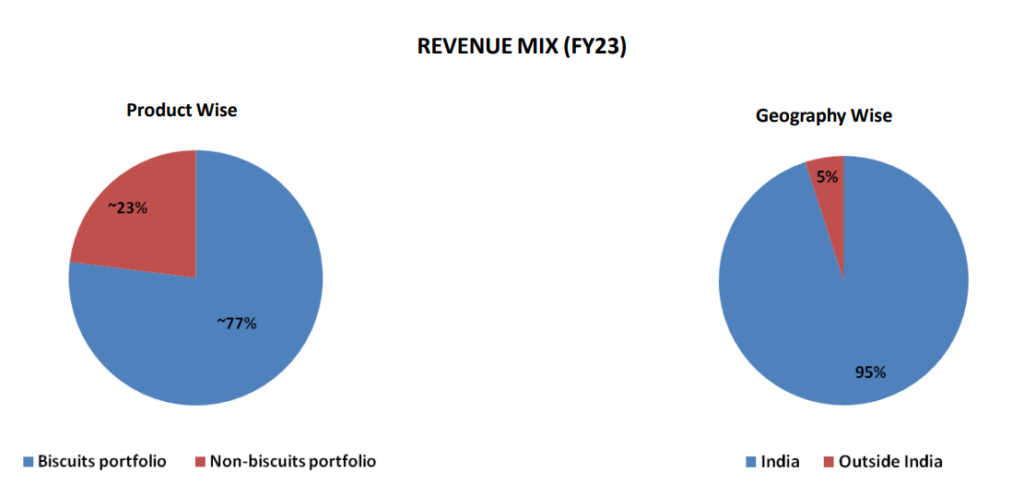
As you see, 77% of the revenue comes from the biscuits segment, while the rest comes from bread, dairy products, cakes, etc. Also, geographically, 95% of revenue comes from India and the remaining 5% is from other countries globally.
Sectoral Outlook – FMCG Sector
The overall size of the Food & Beverages market in India is estimated at USD 800 billion. Within this, the packaged food market constitutes USD 100 billion, with the branded packaged market accounting for USD 40 billion. This indicates significant potential for expansion. Presently, India lags behind China in the packaged food industry by 4.2 times and other Southeast Asian nations, such as the Philippines, by 3.3 times, highlighting substantial room for growth in this sector.
The shift from an unorganized to an organized segment within the industry is expected to persist in India in the upcoming years. Changing consumer preferences and a growing inclination towards adopting branded products in small towns and villages contribute to the expansion of Fast-Moving Consumer Goods (FMCG) companies.
Financial Highlights
Analyzing financial statements such as income statements, balance sheets, and cash flow statements helps investors assess the company’s ability to generate returns, manage debt, and sustain growth, enabling informed and prudent investment choices.
Income statement of Britannia Industries Ltd.
The income statement, commonly known as the profit and loss statement, gives you an understanding of its financial performance, such as its sales growth, profitability, etc.
At StockEdge, we have organized the income statement in a way that will help you analyze it with ease rather than going through the conventional way of downloading the documents from the stock exchanges, which could be time-consuming and tiresome to many.
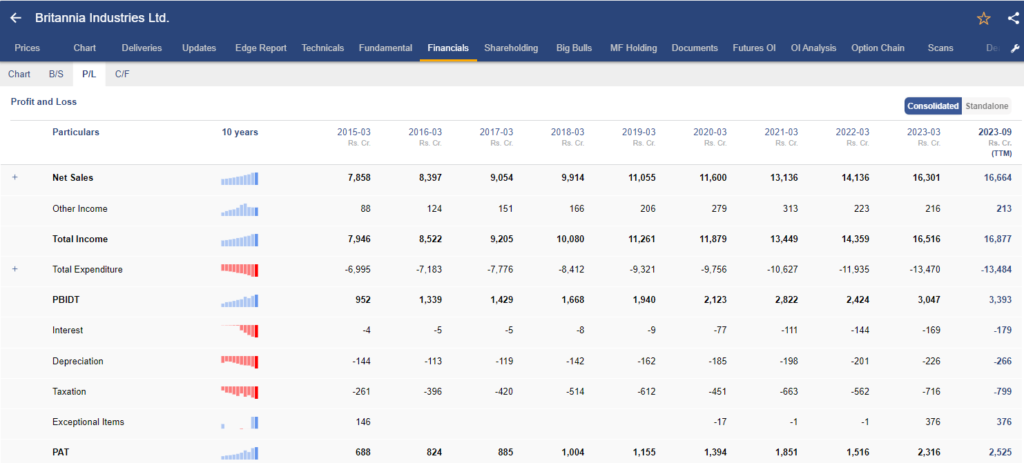
In the above image, you can see the annual income statement of Britannia Industries. Every detail is in front of your eyes, starting from the top-line sales figures to the bottom-line Net profit of the company.
Sales Growth
Although there was a 15% year-on-year increase in sales during the fiscal year 2023, the initial half of fiscal year 2024 recorded net sales of ₹8,444 crore, reflecting a 4% year-on-year growth with no change in volume. The positive performance of the international business was overshadowed by a slowdown in rural areas and increased competition from local players in the domestic market, affecting the overall growth.
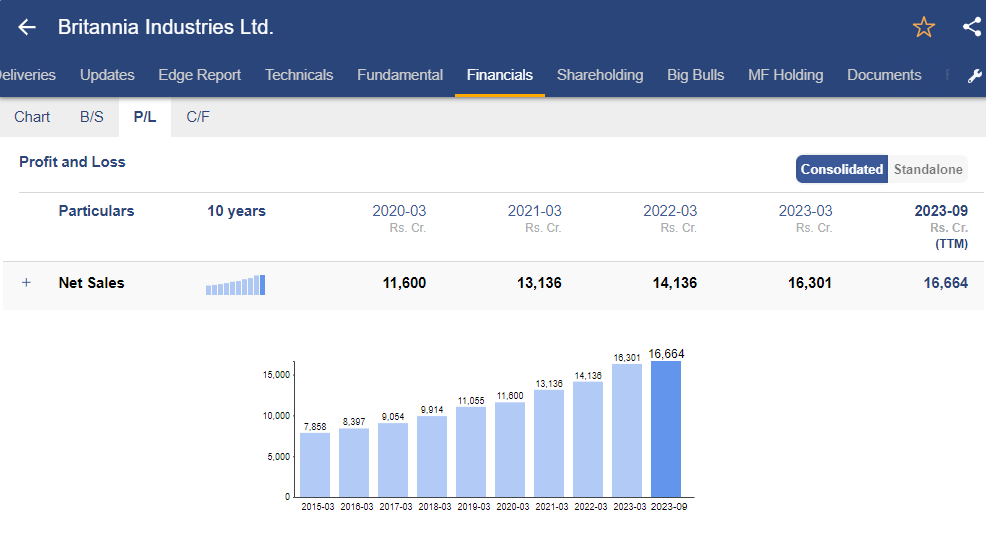
EBITDA Growth
In H1 FY24, EBITDA was ₹1,561 cr, a growth of 29% YoY due to its cost efficiency programs across all functions so as to remain the lowest cost operators in its categories. Nevertheless, there is a simultaneous effort to boost advertising and sales promotion initiatives, aiming to support its brands and foster innovation within the business.
PAT Growth
In the initial half of fiscal year 2024, the Profit After Tax (PAT) amounted to ₹1,040 crore, demonstrating a 12% year-on-year growth. This growth was facilitated by an enhanced operating profit and increased other income. However, the overall growth was somewhat affected by elevated depreciation and interest costs.
Balance Sheet of Britannia Industries Ltd.
The balance sheet follows the accounting equation: Assets = Liabilities + Equity. It provides a company’s financial position, stability, and overall health.
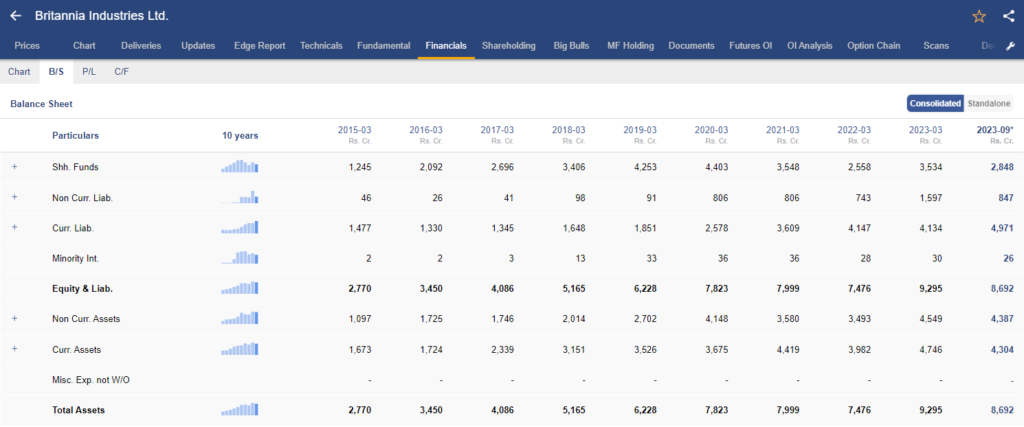
In the above image, you can see the balance sheet of Britannia Industries Ltd. It provides an overview of the financial position as on date. What are the assets and liabilities of the company? Liabilities of a company can be both short term and long term.
As of 30th September 2023, total debt stood at ₹2,761 cr v/s total debt of ₹2,981 cr as of 31st March 2023. Post the COVID era, the company’s overall debt went up, but compared to its total assets, the liabilities are reasonable.
Cash Flow Statement of Britannia Industries Ltd.
A cash flow statement provides a summary of how a company generates and uses cash over a specific period of time. It has three different sections:
- Operating cash flow statement
- Financing cash flow statement
- Investing cash flow statement
Out of these the most important one being the cash flow from operations as it provides you with an understanding of how the company generated cash from its core business operations. A positive cash flow from operation signifies that the company has generated higher cash revenue than its expenditure.

In FY 2023, the Cash Flow from Operations (CFO) amounted to ₹2,526 crore, a significant increase from ₹1,300 crore in FY22. This improvement was driven by enhanced operating profit and adjustments in working capital.
Cash Flow from Investments (CFI) experienced an outflow of ₹1,517 crore, attributable to the acquisition of current investments, inter-corporate deposits (ICDs) extended to group companies, and the procurement of property, plant & equipment.
On the other hand, Cash Flow from Financing (CFF) showed a lower outflow compared to the previous year, as the company secured long-term debt amounting to ₹1,010 crore.
Ratio Analysis of Britannia Industries Share
Ratio analysis of a company involves evaluating a company’s financial performance by examining certain ratios which are derived from its financial statements. It makes easy comparing the financial performance to its industry benchmarks or competitors.
Ratio has different classifications like profitability ratios, solvency ratios, return ratios and more as you can see in the image below, you can analyze all such ratios directly from StockEdge.
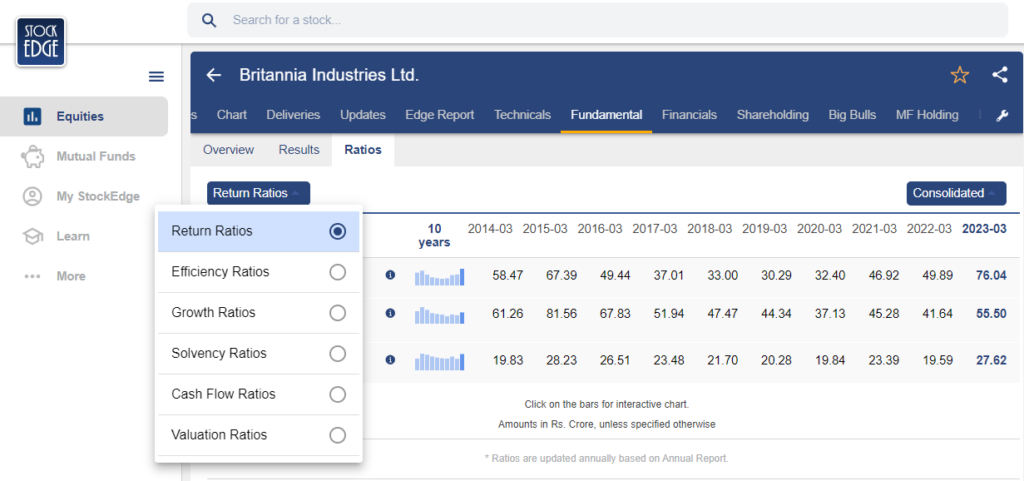
Here are the return ratios of the Britannia Industries share, starting with the two most important ratios which are ROE and ROCE.
What is ROE and ROCE?
ROE is a profitability ratio that measures the company’s ability to generate net income as a percentage of shareholders’ equity, whereas ROCE assesses the efficiency of a company in utilizing its total capital, including both equity and debt.
Return on Equity (ROE)
In FY 2023, the Return on Equity (ROE) reached 76.04%, primarily driven by substantial profit growth. This increase in profit was supported by an exceptional gain of ₹376 crore.
Return on Capital Employed (ROCE)
The robust ROCE of 55.50% in FY23 signifies the efficiency with which the company utilized its capital to generate operating profits. This improvement reflects the company’s effective management of its resources and a positive impact on overall financial performance.
Debt to Equity Ratio (D/E Ratio)
In FY 2023, the company’s debt-to-equity ratio was approximately 0.84x. This ratio indicates that the company had a moderate level of financial leverage. A debt-to-equity ratio of less than 1 is generally considered favorable as it suggests a lower financial risk and indicates a more conservative capital structure.
Price to Equity Ratio
As of the latest data, Britannia Industries is trading at a Trailing Twelve Months (TTM) Price-to-Earnings (PE) multiple of 49.45x. The elevated PE multiple is likely a result of Britannia’s strong brand recall and its leadership position in the domestic market.
The PE multiple reflects the market’s confidence in Britannia’s growth prospects and its ability to capitalize on opportunities in the evolving market conditions.
Management Quality & Shareholding Pattern
The leadership is directing efforts towards implementing localized strategies, consistently innovating products through renovation, introducing new items, and revamping existing ones. Additionally, there is a focus on expanding into related product categories alongside a concerted effort to enhance direct distribution channels and strengthen the company’s presence in rural areas. Management expects the rural segment to improve to 35% of total revenue in the next few months.
Coming to the shareholding pattern of Britannia Industries share, you can check it from the StockEdge App itself.
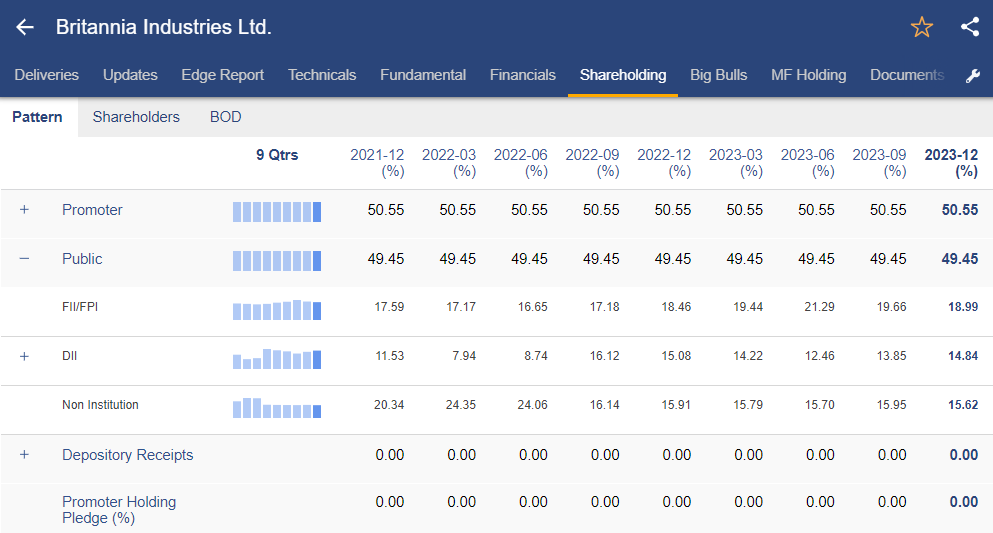
The promoter shareholding continues to remain at 50.55%. FII decreased their stake from 21.29% in Q1 FY24 to 19.66% in Q2 FY24. DII increased their stake from 12.46% in Q1 FY24 to o 13.85% in Q2 FY24.
The changes in shareholding patterns indicate a dynamic shift in investor interest in Britannia Industries shares as both FIIs and DIIs strategically adjust their positions. Notably, the unwavering promoter’s stake emphasizes a consistent and resolute dedication to the company’s growth and performance.
Future Outlook of Britannia Industries Share
The company maintains its commitment to four key strategic pillars: distribution and marketing, cost leadership, innovation, and sustainability. The overarching goal is to achieve well-rounded growth encompassing margin, revenue, volume, and market share. Over the next five years, the company anticipates increasing the contribution of its non-biscuit portfolio to approximately 35% of total revenue, up from the current 23%. Furthermore, there is an ambition to be the top gainers by scaling the dairy segment to ₹2,000 crore within the same timeframe.
Case Study on Britannia Industries Share
We have a case study report prepared by our team of analysts. This fundamental report on Britannia Industries shares provides you with a detailed analysis of the company as well as how it stands among its competitors.
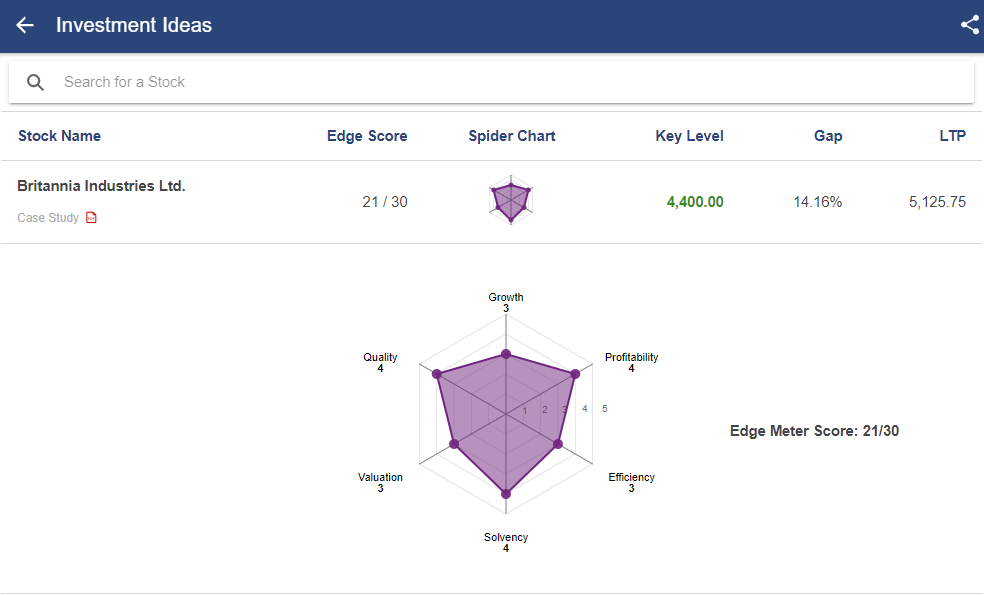
As you can see, Britannia Industries Share has rating based on 6 parameters:
- Growth
- Quality
- Profitability
- Efficiency
- Solvency
- Valuation
Based on the above parameters, Britannia Industries Share scored 21/30. Read the case study report on Britannia Industries Share.
Conclusion
In conclusion, Britannia Industries emerges as a compelling long-term investment opportunity. With a solid foundation anchored in strategic pillars such as distribution, cost leadership, innovation, and sustainability, the company demonstrates a robust commitment to balanced growth. The resilience of its promoter shareholding, coupled with evolving investor interest, reflects confidence in the company’s trajectory. Britannia’s ambitious targets, including expanding its non-biscuit portfolio and scaling its dairy segment, further position it as a forward-looking player in the market. As it continues to navigate dynamic market conditions, Britannia Industries stands out as a promising choice for investors seeking enduring value and growth in their portfolios.
Apart from Nestle India stock, there are other stocks which are part of the Nifty 50 index. Read this blog All About NIFTY50, Components of NIFTY50, and How to Invest in it.
Happy Investing!!










